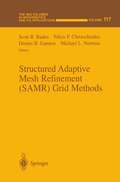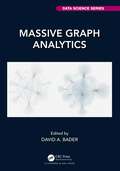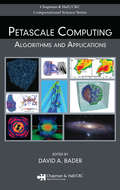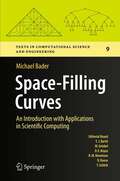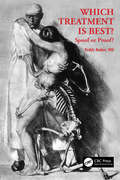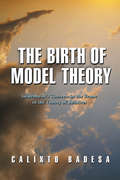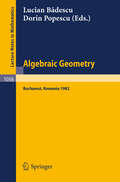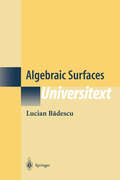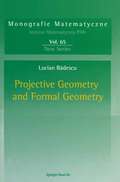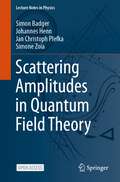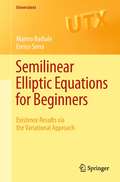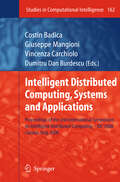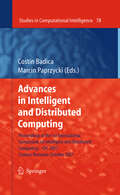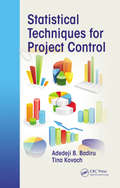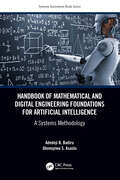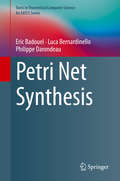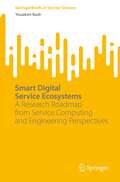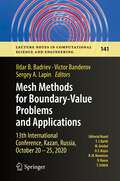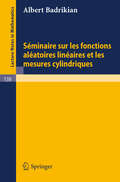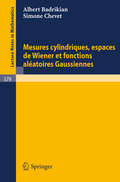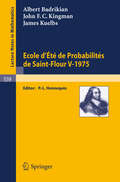- Table View
- List View
Structured Adaptive Mesh Refinement (The IMA Volumes in Mathematics and its Applications #117)
by Scott B. Baden Nikos P. Chrisochoides Dennis B. Gannon Michael L. NormanThe papers presented here describe research to improve the general understanding of the application of SAMR to practical problems, to identify issues critical to efficient and effective implementation on high performance computers and to stimulate the development of a community code repository for software including benchmarks to assist in the evaluation of software and compiler technologies. The ten chapters have been divided into two parts reflecting two major issues in the topic: programming complexity of SAMR algorithms and the applicability and numerical challenges of SAMR methods.
Massive Graph Analytics (Chapman & Hall/CRC Data Science Series)
by David A. BaderExpertise in massive scale graph analytics is key for solving real-world grand challenges from health to sustainability to detecting insider threats, cyber defense, and more. Massive Graph Analytics provides a comprehensive introduction to massive graph analytics, featuring contributions from thought leaders across academia, industry, and government. The book will be beneficial to students, researchers and practitioners, in academia, national laboratories, and industry, who wish to learn about the state-of-the-art algorithms, models, frameworks, and software in massive scale graph analytics.
Massive Graph Analytics (Chapman & Hall/CRC Data Science Series)
by David A. BaderExpertise in massive scale graph analytics is key for solving real-world grand challenges from health to sustainability to detecting insider threats, cyber defense, and more. Massive Graph Analytics provides a comprehensive introduction to massive graph analytics, featuring contributions from thought leaders across academia, industry, and government. The book will be beneficial to students, researchers and practitioners, in academia, national laboratories, and industry, who wish to learn about the state-of-the-art algorithms, models, frameworks, and software in massive scale graph analytics.
Petascale Computing: Algorithms and Applications
by David A. BaderAlthough the highly anticipated petascale computers of the near future will perform at an order of magnitude faster than today's quickest supercomputer, the scaling up of algorithms and applications for this class of computers remains a tough challenge. From scalable algorithm design for massive concurrency toperformance analyses and scientific vis
Space-Filling Curves: An Introduction with Applications in Scientific Computing (Texts in Computational Science and Engineering #9)
by Michael BaderThe present book provides an introduction to using space-filling curves (SFC) as tools in scientific computing. Special focus is laid on the representation of SFC and on resulting algorithms. For example, grammar-based techniques are introduced for traversals of Cartesian and octree-type meshes, and arithmetisation of SFC is explained to compute SFC mappings and indexings.The locality properties of SFC are discussed in detail, together with their importance for algorithms. Templates for parallelisation and cache-efficient algorithms are presented to reflect the most important applications of SFC in scientific computing. Special attention is also given to the interplay of adaptive mesh refinement and SFC, including the structured refinement of triangular and tetrahedral grids. For each topic, a short overview is given on the most important publications and recent research activities.
Which Treatment Is Best? Spoof or Proof?
by Teddy BaderA young woman cries, "Please don’t let me die!" Has she received the best treatment? What is the best treatment? How do we know? Life-threatening disease prompts these questions in everyone. Which Treatment Is Best? Spoof or Proof? explains the best scientific evidence for any treatment—the randomized controlled trial. This book begins with rotten humors as the source of all diseases. The reader is guided through serious attempts in history to treat disease, but which now seem amusing. The story ends with the randomized controlled trial and how to interpret it. The text will help students and clinicians understand this universal language of clinical research worldwide. Key Features Describes the development of the randomized, controlled trial as the gold standard of proof Unravels the meaning of "randomized," "double-blind," and "p-values" in a simplified manner for students and clinicians Contains timeless information on how medical evidence can be understood
Which Treatment Is Best? Spoof or Proof?
by Teddy BaderA young woman cries, "Please don’t let me die!" Has she received the best treatment? What is the best treatment? How do we know? Life-threatening disease prompts these questions in everyone. Which Treatment Is Best? Spoof or Proof? explains the best scientific evidence for any treatment—the randomized controlled trial. This book begins with rotten humors as the source of all diseases. The reader is guided through serious attempts in history to treat disease, but which now seem amusing. The story ends with the randomized controlled trial and how to interpret it. The text will help students and clinicians understand this universal language of clinical research worldwide. Key Features Describes the development of the randomized, controlled trial as the gold standard of proof Unravels the meaning of "randomized," "double-blind," and "p-values" in a simplified manner for students and clinicians Contains timeless information on how medical evidence can be understood
The Birth of Model Theory: Löwenheim's Theorem in the Frame of the Theory of Relatives
by Calixto BadesaLöwenheim's theorem reflects a critical point in the history of mathematical logic, for it marks the birth of model theory--that is, the part of logic that concerns the relationship between formal theories and their models. However, while the original proofs of other, comparably significant theorems are well understood, this is not the case with Löwenheim's theorem. For example, the very result that scholars attribute to Löwenheim today is not the one that Skolem--a logician raised in the algebraic tradition, like Löwenheim--appears to have attributed to him. In The Birth of Model Theory, Calixto Badesa provides both the first sustained, book-length analysis of Löwenheim's proof and a detailed description of the theoretical framework--and, in particular, of the algebraic tradition--that made the theorem possible. Badesa's three main conclusions amount to a completely new interpretation of the proof, one that sharply contradicts the core of modern scholarship on the topic. First, Löwenheim did not use an infinitary language to prove his theorem; second, the functional interpretation of Löwenheim's normal form is anachronistic, and inappropriate for reconstructing the proof; and third, Löwenheim did not aim to prove the theorem's weakest version but the stronger version Skolem attributed to him. This book will be of considerable interest to historians of logic, logicians, philosophers of logic, and philosophers of mathematics.
The Birth of Model Theory: Löwenheim's Theorem in the Frame of the Theory of Relatives
by Calixto BadesaLöwenheim's theorem reflects a critical point in the history of mathematical logic, for it marks the birth of model theory--that is, the part of logic that concerns the relationship between formal theories and their models. However, while the original proofs of other, comparably significant theorems are well understood, this is not the case with Löwenheim's theorem. For example, the very result that scholars attribute to Löwenheim today is not the one that Skolem--a logician raised in the algebraic tradition, like Löwenheim--appears to have attributed to him. In The Birth of Model Theory, Calixto Badesa provides both the first sustained, book-length analysis of Löwenheim's proof and a detailed description of the theoretical framework--and, in particular, of the algebraic tradition--that made the theorem possible. Badesa's three main conclusions amount to a completely new interpretation of the proof, one that sharply contradicts the core of modern scholarship on the topic. First, Löwenheim did not use an infinitary language to prove his theorem; second, the functional interpretation of Löwenheim's normal form is anachronistic, and inappropriate for reconstructing the proof; and third, Löwenheim did not aim to prove the theorem's weakest version but the stronger version Skolem attributed to him. This book will be of considerable interest to historians of logic, logicians, philosophers of logic, and philosophers of mathematics.
Algebraic Geometry: Proceedings of the International Conference held in Bucharest, Romania, August 2–7, 1982 (Lecture Notes in Mathematics #1056)
by L. Badescu D. PopescuAlgebraic Surfaces (Universitext)
by Lucian BadescuThis book presents fundamentals from the theory of algebraic surfaces, including areas such as rational singularities of surfaces and their relation with Grothendieck duality theory, numerical criteria for contractibility of curves on an algebraic surface, and the problem of minimal models of surfaces. In fact, the classification of surfaces is the main scope of this book and the author presents the approach developed by Mumford and Bombieri. Chapters also cover the Zariski decomposition of effective divisors and graded algebras.
Projective Geometry and Formal Geometry (Monografie Matematyczne #65)
by Lucian BadescuThe aim of this monograph is to introduce the reader to modern methods of projective geometry involving certain techniques of formal geometry. Some of these methods are illustrated in the first part through the proofs of a number of results of a rather classical flavor, involving in a crucial way the first infinitesimal neighbourhood of a given subvariety in an ambient variety. Motivated by the first part, in the second formal functions on the formal completion X/Y of X along a closed subvariety Y are studied, particularly the extension problem of formal functions to rational functions. The formal scheme X/Y, introduced to algebraic geometry by Zariski and Grothendieck in the 1950s, is an analogue of the concept of a tubular neighbourhood of a submanifold of a complex manifold. It is very well suited to study the given embedding Y\subset X. The deep relationship of formal geometry with the most important connectivity theorems in algebraic geometry, or with complex geometry, is also studied. Some of the formal methods are illustrated and applied to homogeneous spaces.The book contains a lot of results obtained over the last thirty years, many of which never appeared in a monograph or textbook. It addresses to algebraic geometers as well as to those interested in using methods of algebraic geometry.
Scattering Amplitudes in Quantum Field Theory (Lecture Notes in Physics #1021)
by Simon Badger Johannes Henn Jan Christoph Plefka Simone ZoiaThis open access book bridges a gap between introductory Quantum Field Theory (QFT) courses and state-of-the-art research in scattering amplitudes. It covers the path from basic definitions of QFT to amplitudes, which are relevant for processes in the Standard Model of particle physics. The book begins with a concise yet self-contained introduction to QFT, including perturbative quantum gravity. It then presents modern methods for calculating scattering amplitudes, focusing on tree-level amplitudes, loop-level integrands and loop integration techniques. These methods help to reveal intriguing relations between gauge and gravity amplitudes and are of increasing importance for obtaining high-precision predictions for collider experiments, such as those at the Large Hadron Collider, as well as for foundational mathematical physics studies in QFT, including recent applications to gravitational wave physics.These course-tested lecture notes include numerous exercises with solutions. Requiring only minimal knowledge of QFT, they are well-suited for MSc and PhD students as a preparation for research projects in theoretical particle physics. They can be used as a one-semester graduate level course, or as a self-study guide for researchers interested in fundamental aspects of quantum field theory.
Semilinear Elliptic Equations for Beginners: Existence Results via the Variational Approach (Universitext)
by Marino Badiale Enrico SerraSemilinear elliptic equations are of fundamental importance for the study of geometry, physics, mechanics, engineering and life sciences. The variational approach to these equations has experienced spectacular success in recent years, reaching a high level of complexity and refinement, with a multitude of applications. Additionally, some of the simplest variational methods are evolving as classical tools in the field of nonlinear differential equations. This book is an introduction to variational methods and their applications to semilinear elliptic problems. Providing a comprehensive overview on the subject, this book will support both student and teacher engaged in a first course in nonlinear elliptic equations. The material is introduced gradually, and in some cases redundancy is added to stress the fundamental steps in theory-building. Topics include differential calculus for functionals, linear theory, and existence theorems by minimization techniques and min-max procedures. Requiring a basic knowledge of Analysis, Functional Analysis and the most common function spaces, such as Lebesgue and Sobolev spaces, this book will be of primary use to graduate students based in the field of nonlinear partial differential equations. It will also serve as valuable reading for final year undergraduates seeking to learn about basic working tools from variational methods and the management of certain types of nonlinear problems.
Intelligent Distributed Computing, Systems and Applications: Proceedings of the 2nd International Symposium on Intelligent Distributed Computing – IDC 2008, Catania, Italy, 2008 (Studies in Computational Intelligence #162)
by Costin Badica Giuseppe Mangioni Vincenza Carchiolo Dumitru Dan BurdescuThis book represents the peer-reviewed proceedings of the Second International Symposium on Intelligent Distributed Computing – IDC 2008 held in Catania, Italy during September 18-19, 2008. The 35 contributions in this book address many topics related to intelligent and distributed computing, systems and applications, including: adaptivity and learning; agents and multi-agent systems; argumentation; auctions; case-based reasoning; collaborative systems; data structures; distributed algorithms; formal modeling and verification; genetic and immune algorithms; grid computing; information extraction, annotation and integration; network and security protocols; mobile and ubiquitous computing; ontologies and metadata; P2P computing; planning; recommender systems; rules; semantic Web; services and processes; trust and social computing; virtual organizations; wireless networks; XML technologies.
Advances in Intelligent and Distributed Computing: Proceedings of the 1st International Symposium on Intelligent and Distributed Computing IDC 2007, Craiova, Romania, October 2007 (Studies in Computational Intelligence #78)
by Costin Badica Marcin PaprzyckiThis book presents the proceedings of the 1st International Symposium on Intelligent and Distributed Computing, IDC 2007, held in Craiova, Romania, October 2007. Coverage includes: autonomous and adaptive computing; data mining and knowledge discovery; distributed problem solving and decision making; e-business, e-health and e-learning; genetic algorithms; image processing; information retrieval; intelligence in mobile and ubiquitous computing.
Statistical Techniques for Project Control
by Adedeji B. Badiru Tina AgustiadyWinner of the IIE Book of the Month for June 2012A project can be simple or complex. In each case, proven project management processes must be followed. In all cases of project management implementation, control must be exercised in order to assure that project objectives are achieved. Statistical Techniques for Project Control seamlessly integrate
Handbook of Mathematical and Digital Engineering Foundations for Artificial Intelligence: A Systems Methodology (Systems Innovation Book Series)
by Adedeji B. Badiru Olumuyiwa AsaoluArtificial intelligence (AI) and digital engineering have become prevalent in business, industry, government, and academia. However, the workforce still has a lot to learn on how to leverage them. This handbook presents the preparatory and operational foundations for the efficacy, applicability, risk, and how to take advantage of these tools and techniques. Handbook of Mathematical and Digital Engineering Foundations for Artificial Intelligence: A Systems Methodology provides a guide for using digital engineering platforms for advancing AI applications. The book discusses an interface of education and research in the pursuit of AI developments and highlights the facilitation of advanced education through AI and digital engineering systems. It presents an integration of soft and hard skills in developing and using AI and offers a rigorous systems approach to understanding and using AI. This handbook will be the go-to resource for practitioners and students on applying systems methodology to the body of knowledge of understanding, embracing, and using digital engineering tools and techniques. The recent developments and emergence of Chatbots (AI tools) all have mathematical foundations for their efficacy. Such AI tools include ChatGPT, GPT-4, Bard, Tidio Support Bot, Kuki AI Companion, Meena, BlenderBot, Rose AI Chatbot, Replika: AI Friend, Eviebot, and Tay. This handbook highlights the importance of mathematical and digital foundations for AI developments. The handbook will enhance the understanding and appreciation of readers about the prevailing wave of artificial intelligence products, and, thereby, fitting the current market needs.
Handbook of Mathematical and Digital Engineering Foundations for Artificial Intelligence: A Systems Methodology (Systems Innovation Book Series)
by Adedeji B. Badiru Olumuyiwa AsaoluArtificial intelligence (AI) and digital engineering have become prevalent in business, industry, government, and academia. However, the workforce still has a lot to learn on how to leverage them. This handbook presents the preparatory and operational foundations for the efficacy, applicability, risk, and how to take advantage of these tools and techniques. Handbook of Mathematical and Digital Engineering Foundations for Artificial Intelligence: A Systems Methodology provides a guide for using digital engineering platforms for advancing AI applications. The book discusses an interface of education and research in the pursuit of AI developments and highlights the facilitation of advanced education through AI and digital engineering systems. It presents an integration of soft and hard skills in developing and using AI and offers a rigorous systems approach to understanding and using AI. This handbook will be the go-to resource for practitioners and students on applying systems methodology to the body of knowledge of understanding, embracing, and using digital engineering tools and techniques. The recent developments and emergence of Chatbots (AI tools) all have mathematical foundations for their efficacy. Such AI tools include ChatGPT, GPT-4, Bard, Tidio Support Bot, Kuki AI Companion, Meena, BlenderBot, Rose AI Chatbot, Replika: AI Friend, Eviebot, and Tay. This handbook highlights the importance of mathematical and digital foundations for AI developments. The handbook will enhance the understanding and appreciation of readers about the prevailing wave of artificial intelligence products, and, thereby, fitting the current market needs.
Petri Net Synthesis (Texts in Theoretical Computer Science. An EATCS Series)
by Eric Badouel Luca Bernardinello Philippe DarondeauThis book is a comprehensive, systematic survey of the synthesis problem, and of region theory which underlies its solution, covering the related theory, algorithms, and applications. The authors focus on safe Petri nets and place/transition nets (P/T-nets), treating synthesis as an automated process which, given behavioural specifications or partial specifications of a system to be realized, decides whether the specifications are feasible, and then produces a Petri net realizing them exactly, or if this is not possible produces a Petri net realizing an optimal approximation of the specifications.In Part I the authors introduce elementary net synthesis. In Part II they explain variations of elementary net synthesis and the unified theory of net synthesis. The first three chapters of Part III address the linear algebraic structure of regions, synthesis of P/T-nets from finite initialized transition systems, and the synthesis of unbounded P/T-nets. Finally, the last chapter in Part III and the chapters in Part IV cover more advanced topics and applications: P/T-net with the step firing rule, extracting concurrency from transition systems, process discovery, supervisory control, and the design of speed-independent circuits.Most chapters conclude with exercises, and the book is a valuable reference for both graduate students of computer science and electrical engineering and researchers and engineers in this domain.
Smart Digital Service Ecosystems: A Research Roadmap from Service Computing and Engineering Perspectives (SpringerBriefs in Service Science)
by Youakim BadrThis book provides a holistic overview of the major advances that have been made in the context of Service Science with a focus on IT-enabled services. To address challenges in collaborative, social-centric, ad-hoc, dynamic and open environments, the book studies IT-enabled service systems from two distinct but complementary research perspectives: service engineering and service computing. From a service engineering view, the book shows how to apply a systemic approach to tackle social problems from holistic and multi-disciplinary perspectives by focusing on service systems and developing a service design framework, including socio-technical aspects, the service reference model, data-driven collaboration processes, the incremental design method, requirement propagation, and system adaptability with feedback loops. From a service computing view, the book introduces a service-oriented aided infrastructure to support IT-enabled service systems in ICT-facilitated environments and provide access to tangible and intangible resources in a trustworthy environment. The book offers a valuable companion and comprehensive reference guide for undergraduate and graduate students who want to learn about current concepts for designing and implementing service systems; and for researchers who want to identify future directions in build smart digital service ecosystems, integrating Internet of Things (IoT) and Artificial Intelligence (AI) and cyber-security. The book also appeals to developers who need to implement advanced services and want to capitalize on corresponding business models, customer-driven interaction, and scalable architectures.
Mesh Methods for Boundary-Value Problems and Applications: 13th International Conference, Kazan, Russia, October 20-25, 2020 (Lecture Notes in Computational Science and Engineering #141)
by Ildar B. Badriev Victor Banderov Sergey A. LapinThis book gathers papers presented at the 13th International Conference on Mesh Methods for Boundary-Value Problems and Applications, which was held in Kazan, Russia, in October 2020. The papers address the following topics: the theory of mesh methods for boundary-value problems in mathematical physics; non-linear mathematical models in mechanics and physics; algorithms for solving variational inequalities; computing science; and educational systems. Given its scope, the book is chiefly intended for students in the fields of mathematical modeling science and engineering. However, it will also benefit scientists and graduate students interested in these fields.
